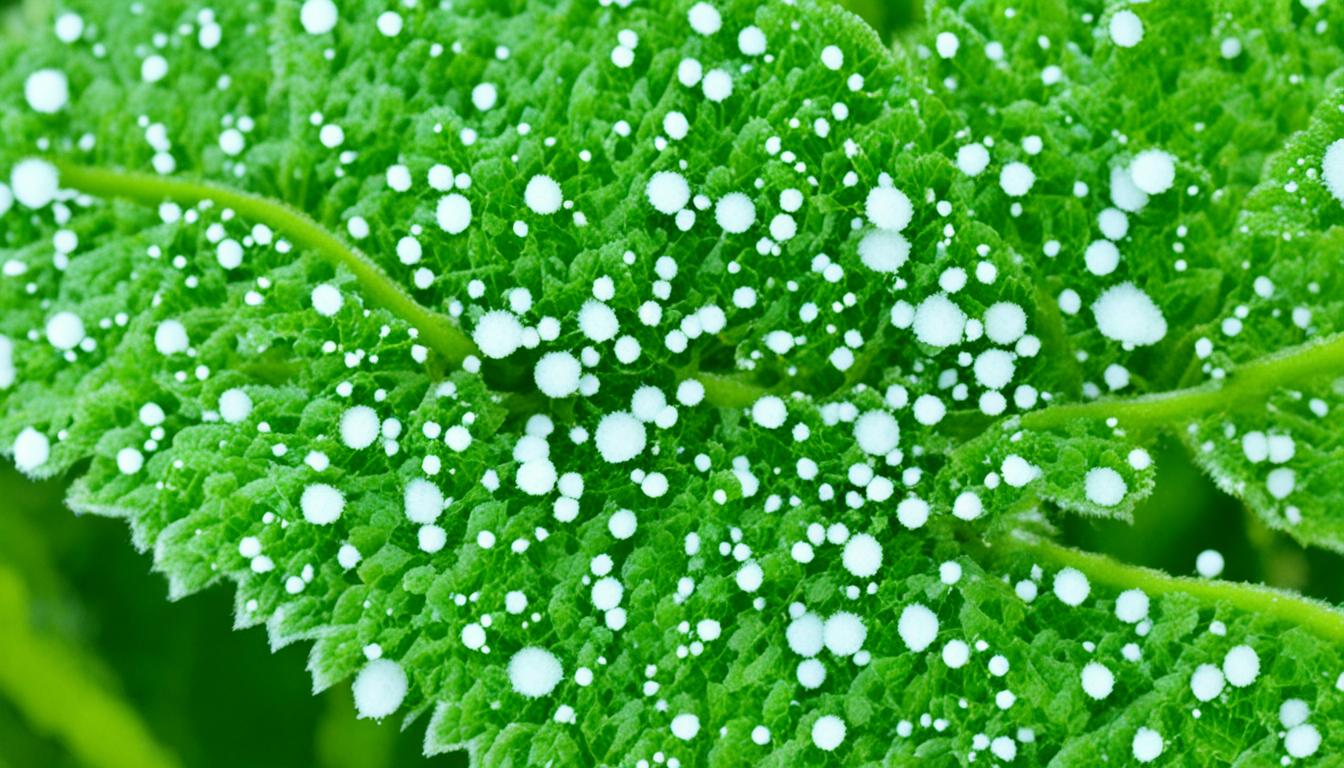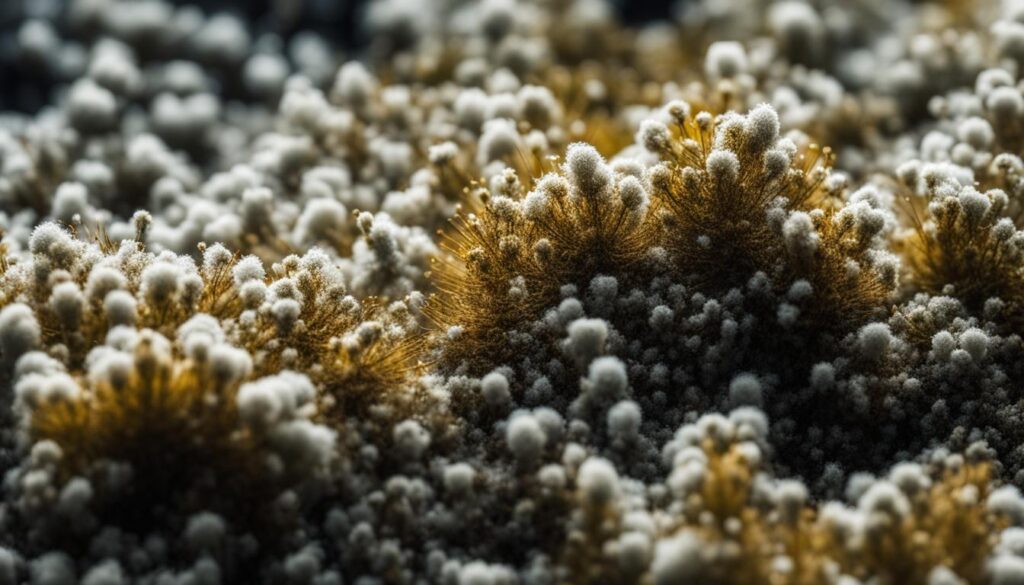
Understanding White Mold: Causes & Remedies
Welcome to our comprehensive guide on white mold. In this section, we will delve into the causes and effective remedies for white mold, providing you with essential knowledge to combat this common household issue.
White mold is a type of fungus that can develop in various areas of your home, including walls, ceilings, and even furniture. It is characterized by its fluffy white appearance, often resembling a powdery substance. If left untreated, white mold can pose health risks to you and your family, as well as cause structural damage to your property.
By understanding the underlying causes of white mold, you can take proactive steps to prevent its growth and implement effective remedies to eliminate it. From excessive moisture to poor ventilation, there are several factors that contribute to the development of white mold. We will explore these causes in detail and provide actionable solutions to address them.
Throughout this guide, we will also discuss how to identify white mold and the common areas of your home where it is frequently found. This knowledge will enable you to spot white mold early on, allowing you to take immediate action to mitigate its spread.
As we continue, we will share a range of effective remedies for white mold. These remedies include improving ventilation, reducing moisture levels, and implementing proper cleaning and maintenance routines. Additionally, we will touch on situations where professional mold remediation services may be necessary.
With the insights gained from this guide, you will be equipped to prevent and address white mold issues in your home, ensuring a safe and healthy living environment for yourself and your loved ones.
Key Takeaways:
- White mold is a common fungus that can develop in various areas of your home.
- Understanding the causes of white mold will help you prevent its growth.
- Identifying white mold early on is crucial for effective mitigation.
- Implementing proper ventilation, reducing moisture, and maintaining cleanliness are key remedies for white mold.
- Professional mold remediation services may be necessary for severe cases of white mold infestation.
Identifying White Mold
When it comes to keeping your home safe and healthy, identifying white mold is crucial. In this section, we will discuss how to recognize and differentiate white mold from other types of mold commonly found in homes. By understanding the distinct characteristics and appearance of white mold, you will be able to take immediate action to mitigate its spread and potential health risks.
Distinct Characteristics and Appearance
White mold typically appears as a fuzzy, powdery substance on various surfaces. It thrives in damp and humid environments, making it commonly found in areas such as basements, bathrooms, and kitchens. Unlike other types of mold that may have a green or black appearance, white mold stands out due to its pale color.
White mold tends to grow on organic materials, including wood, paper, fabric, and even food. It can often be found in corners, along windowsills, and beneath sink cabinets where moisture can accumulate. Additionally, white mold can develop on walls, ceilings, and other surfaces that have been exposed to moisture or water leaks.
Did You Know?
White mold is not always visible to the naked eye, as it can also grow hidden behind walls or underneath carpets. Therefore, it’s important to remain vigilant and address any musty odors or signs of moisture in your home.
How to Identify White Mold
- Inspect your home for any visible signs of white mold, such as fuzzy white patches or discoloration on surfaces.
- Pay attention to musty odors, which can indicate the presence of mold, even if it is not immediately visible.
- Check areas prone to moisture or water leaks, as white mold thrives in damp environments.
- Monitor your indoor humidity levels using a hygrometer, as high humidity can promote mold growth.
- Consider conducting a professional mold inspection if you suspect white mold but are unsure of its exact presence or location.
By being proactive in identifying white mold, you can take swift action to prevent its further growth and address any potential health risks. Now that you’re equipped with the knowledge of identifying white mold, let’s delve deeper into its causes in the next section.
| Distinct Characteristics | Common Areas of Infestation |
|---|---|
| • Fuzzy, powdery substance • Pale color |
• Basements • Bathrooms • Kitchens • Corners and windowsills • Sink cabinets • Walls and ceilings |
Causes of White Mold
White mold in homes can be caused by various environmental factors. Understanding these causes is essential for effectively preventing and addressing white mold issues. Let’s explore some of the key factors that promote the growth of white mold:
Excessive Moisture
One of the primary causes of white mold is excessive moisture in indoor environments. Areas with high humidity levels and water leaks provide the perfect conditions for mold growth. Common sources of moisture include plumbing leaks, roof leaks, condensation, and flooding. It’s crucial to address any moisture issues promptly to prevent the formation of white mold.
Poor Ventilation
Inadequate ventilation within a home can contribute to the development of white mold. When there is a lack of fresh air circulation, moisture tends to linger and accumulate, creating a damp environment that encourages mold growth. Poorly ventilated bathrooms, kitchens, basements, and crawl spaces are particularly susceptible to white mold infestations.
Organic Materials as Food Sources
White mold thrives on organic materials such as wood, paper, fabric, and even certain types of food. When these materials are exposed to moisture, it provides a food source for mold to grow and spread. This is why you may often find white mold on wet building materials, damp carpets, or even stored organic materials in humid areas.
To effectively prevent white mold, it’s essential to address these underlying causes. By controlling moisture levels, improving ventilation, and eliminating potential organic food sources, you can create an environment that is less conducive to mold growth.
If you suspect white mold in your home, it’s important to take immediate action to protect your property and your health. Consider reaching out to a professional mold remediation service like Fix Mold Miami, Florida’s trusted experts in mold assessments, prevention, and remediation. Call them today at 305-465-6653 for a professional mold assessment.

Effective Remedies for White Mold
White mold can be a persistent and concerning issue in your home. To effectively combat white mold, it is crucial to implement remedies that target its growth factors and prevent further infestation. In this section, we will discuss various strategies to address white mold and restore a safe and healthy living environment.
1. Improve Ventilation
Proper ventilation plays a significant role in preventing white mold growth. By increasing air circulation and reducing humidity levels, you can create an inhospitable environment for mold. Consider the following steps to improve ventilation:
- Open windows and doors to promote airflow.
- Install exhaust fans in high-moisture areas such as bathrooms, kitchens, and basements.
- Use dehumidifiers to control and maintain optimal humidity levels.
2. Reduce Moisture Levels
Excess moisture is a primary contributor to white mold growth. Taking measures to reduce moisture levels in your home can significantly reduce the risk of mold infestation. Here are some effective remedies:
- Repair any leaks in plumbing, roofs, or windows.
- Ensure proper drainage around your home’s foundation.
- Use moisture barriers and sealants in areas prone to dampness.
3. Implement Cleaning and Maintenance Routines
Regular cleaning and maintenance can help prevent white mold growth and keep your home free from mold spores. Consider the following practices:
- Regularly clean and disinfect surfaces prone to moisture, such as bathrooms and kitchens.
- Vacuum and clean carpets and upholstery to remove any mold spores.
- Inspect and clean air ducts and filters to ensure proper airflow and ventilation.
4. Professional Mold Remediation
In severe cases of white mold infestation, it may be necessary to seek professional mold remediation services. Professional mold removal experts have the knowledge, tools, and experience to effectively identify and address the root causes of white mold growth. They can safely remove the mold and implement preventive measures to minimize the risk of future infestation.
“It’s essential to take prompt action when dealing with white mold. By implementing effective remedies and seeking professional assistance when needed, you can effectively eliminate white mold and maintain a healthy living space for you and your family.” – Expert Mold Remediation Specialist
Remember, prevention is key when it comes to white mold. By addressing the underlying causes and implementing these effective remedies, you can successfully combat white mold and protect your home from further infestation.

| Remedies | Description |
|---|---|
| Improve Ventilation | Enhancing airflow and reducing humidity levels through open windows, exhaust fans, and dehumidifiers. |
| Reduce Moisture Levels | Addressing leaks, ensuring proper drainage, and using moisture barriers and sealants to minimize moisture accumulation. |
| Implement Cleaning and Maintenance Routines | Regularly cleaning and disinfecting moisture-prone areas, vacuuming carpets and upholstery, and inspecting air ducts and filters. |
| Professional Mold Remediation | Seeking expert assistance for severe white mold infestations to safely remove mold and prevent future growth. |
Conclusion
In conclusion, understanding the causes of white mold and implementing effective remedies is crucial for maintaining a safe and healthy home environment. By being proactive in identifying and addressing white mold issues, you can prevent potential damage to your property and safeguard your family’s well-being.
If you suspect white mold in your home, consider reaching out to Fix Mold Miami, Florida’s highest-rated in mold assessments, prevention, and remediation company, at 305-465-6653 for a professional mold assessment. Their experienced team can provide expert guidance and solutions to ensure the complete removal and prevention of white mold, restoring your home to a clean and mold-free state.
Don’t let white mold compromise the health and safety of your loved ones. Take action today and trust Fix Mold Miami to handle all your mold-related concerns.




